An alternate splicing variant of the human telomerase catalytic subunit inhibits telomerase activity
- PMID: 11191110
- PMCID: PMC1507981
- DOI: 10.1038/sj.neo.7900113
An alternate splicing variant of the human telomerase catalytic subunit inhibits telomerase activity
Abstract
Telomerase, a cellular reverse transcriptase, adds telomeric repeats to chromosome ends. In normal human somatic cells, telomerase is repressed and telomeres progressively shorten, leading to proliferative senescence. Introduction of the telomerase (hTERT) cDNA is sufficient to produce telomerase activity and immortalize normal human cells, suggesting that the repression of telomerase activity is transcriptional. The telomerase transcript has been shown to have at least six alternate splicing sites (four insertion sites and two deletion sites), and variants containing both or either of the deletion sites are present during development and in a panel of cancer cell lines we surveyed. One deletion (beta site) and all four insertions cause premature translation terminations, whereas the other deletion (alpha site) is 36 bp and lies within reverse transcriptase (RT) motif A, suggesting that this deletion variant may be a candidate as a dominant-negative inhibitor of telomerase. We have cloned three alternately spliced hTERT variants that contain the alpha, beta or both alpha and beta deletion sites. These alternate splicing variants along with empty vector and wild-type hTERT were introduced into normal human fibroblasts and several telomerase-positive immortal and tumor cell lines. Expression of the alpha site deletion variant (hTERT alpha-) construct was confirmed by Western blotting. We found that none of the three alternate splicing variants reconstitutes telomerase activity in fibroblasts. However, hTERT alpha- inhibits telomerase activities in telomerase-positive cells, causes telomere shortening and eventually cell death. This alternately spliced dominant-negative variant may be important in understanding telomerase regulation during development, differentiation and in cancer progression.
Figures
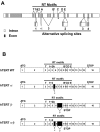

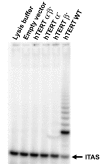

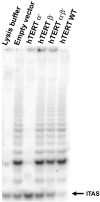

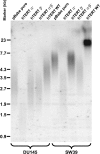
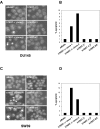
Similar articles
-
The hTERTalpha splice variant is a dominant negative inhibitor of telomerase activity.Neoplasia. 2000 Sep-Oct;2(5):426-32. doi: 10.1038/sj.neo.7900112. Neoplasia. 2000. PMID: 11191109 Free PMC article.
-
Quantitation of telomerase components and hTERT mRNA splicing patterns in immortal human cells.Nucleic Acids Res. 2001 Dec 1;29(23):4818-25. doi: 10.1093/nar/29.23.4818. Nucleic Acids Res. 2001. PMID: 11726691 Free PMC article.
-
Human telomerase reverse transcriptase promoter regulation in normal and malignant human ovarian epithelial cells.Cancer Res. 2001 Jul 15;61(14):5529-36. Cancer Res. 2001. PMID: 11454703
-
Multiple pathways to cellular senescence: role of telomerase repressors.Eur J Cancer. 1997 Apr;33(5):710-5. doi: 10.1016/S0959-8049(97)00090-7. Eur J Cancer. 1997. PMID: 9282109 Review.
-
Telomeres, telomerase, and myc. An update.Mutat Res. 2000 Jan;462(1):31-47. doi: 10.1016/s1383-5742(99)00091-5. Mutat Res. 2000. PMID: 10648922 Review.
Cited by
-
Telomerase reverse transcriptase expression protects transformed human cells against DNA-damaging agents, and increases tolerance to chromosomal instability.Oncogene. 2016 Jan 14;35(2):218-27. doi: 10.1038/onc.2015.75. Epub 2015 Apr 20. Oncogene. 2016. PMID: 25893297
-
The tamoxifen-induced suppression of telomerase activity in the human hepatoblastoma cell line HepG2: a result of post-translational regulation.J Cancer Res Clin Oncol. 2005 Feb;131(2):120-8. doi: 10.1007/s00432-004-0589-0. Epub 2004 Oct 16. J Cancer Res Clin Oncol. 2005. PMID: 15503139 Free PMC article.
-
Extended longevity of termite kings and queens is accompanied by extranuclear localization of telomerase in somatic organs and caste-specific expression of its isoforms.Insect Sci. 2025 Apr;32(2):364-384. doi: 10.1111/1744-7917.13418. Epub 2024 Jul 21. Insect Sci. 2025. PMID: 39034424 Free PMC article.
-
Telomerase Regulation: A Role for Epigenetics.Cancers (Basel). 2021 Mar 10;13(6):1213. doi: 10.3390/cancers13061213. Cancers (Basel). 2021. PMID: 33802026 Free PMC article. Review.
-
Prognostic Alternative Splicing Signatures in Esophageal Carcinoma.Cancer Manag Res. 2021 Jun 4;13:4509-4527. doi: 10.2147/CMAR.S305464. eCollection 2021. Cancer Manag Res. 2021. PMID: 34113176 Free PMC article. Review.
References
-
- Hayflick L. The limited in vitro lifetime of human diploid cell strains. Exp Cell Res. 1965;37:614–636. - PubMed
-
- Hayflick L, Moorhead PS. The serial cultivation of human diploid cell strains. Exp Cell Res. 1961;25:585–621. - PubMed
-
- Olovnikov AM. A theory of marginotomy. The incomplete copying of template margin in enzymic synthesis of polynucleotides and biological significance of the phenomenon. J Theor Biol. 1973;41:181–190. - PubMed
-
- Watson JD. Origin of concatemeric T7 DNA. Nature (London) New Biol. 1972;239:197–201. - PubMed
Publication types
MeSH terms
Substances
Grants and funding
LinkOut - more resources
Full Text Sources
Other Literature Sources
